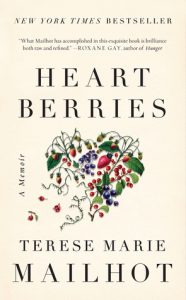ASTU 100 at UBC has explored many different facets of life narratives. As such any future texts to be looked at ought to bring something new and unique to the table, which is why I propose Heart Berries by Terese Marie Mailhot. It documents her traumatic childhood living in poverty on the Seabird Island First Nation Indian reservation with an abusive, alcoholic father (Evans), her struggles with her identity in a country that heavily stereotypes Indigenous peoples (“’We Don’t See a Person’”), and her experiences with mental illness. In doing so, Mailhot is able to reconcile herself with her past, and “seizes control of her story” (“Heart Berries”).

Donna Cheng. Heart Berries Book Cover. Courtesy of Goodreads.
Because it deals with the intersection of many topics discussed in class, such as memory (“Heart Berries”), identity, and self-representation (“’We Don’t See a Person’”), Heart Berries has the potential to extend these discussions in a new way. Further, because it deals with indigeneity, a topic only briefly discussed in ASTU 100, it can expand students’ understanding of Canada’s colonial history and the power memoir can have in resisting the effects of this history. To demonstrate the memoir’s value to literary studies students, I’ll briefly explore two potential avenues for research; how it bears witness to marginalization, and issues of who has the authority to speak for a group.
One potential topic for future students to look at is how the memoir bears witness to the marginalization of Indigenous peoples and people with mental illnesses. The work of Schaffer and Smith on how life narratives can present “alternative or counter-histories coming from the margins” and the impacts this can have on human rights (4) could be applied here. Mailhot’s personal experiences, as outlined in her memoir, may be seen to bear witness to the discrimination she likely faced as a mentally ill, Indigenous woman. As such, it could be argued that the memoir has the potential to impact the way the public sees such marginalized groups, and thus can possibly increase human rights for them (Schaffer and Smith 1).
Issues around who has the authority to speak for a marginalized group, and what the implications of this are could also be raised. In line with Couser’s assertion that disability life narratives (though his conclusions are more broadly applicable) often conform to certain rhetorics that can inhibit their potential to challenge common perceptions (31-48), an argument could be made that Heart Berries conforms to the so-called rhetoric of “triumph over adversity” (33). Seeing as Mailhot, who is now a successful, “post doctoral fellow at Purdue University” (“‘We Don’t See a Person’”), can be seen to have overcome the traumas of her past (though this is not to say she has overcome her indigeneity), she may be perceived as a more authoritative narrator than those who are still bound by their pasts. In contrast with the analysis based on Schaffer and Smith, Couser’s framework suggests that this lessens the ability of the memoir to act as a counter-narrative, as it only “removes the stigma… from the author” (34).
There’s the potential for many discussions around representation, trauma, memory, and more in regard to Terese Marie Mailhot’s memoir Heart Berries, which is why it is such a fruitful memoir for burgeoning literary scholars to examine. In-depth analyses of this memoir could illuminate not only how it bears witness to marginalization, and who is considered an “authoritative” narrator, but also could add to the larger scholarly conversation on the potential for life narratives to challenge existing perceptions (Couser 31, Schaffer and Smith 4). It is for these reasons that I propose Heart Berries as the next text for ASTU classes to read, in the hopes that it enriches their understanding of life narratives.
Works Cited
Cheng, Donna. Heart Berries Book Cover. Goodreads, www.goodreads.com/book/show/35840657-heart-berries?from_choice=true.
Couser, G. Thomas. “Rhetoric and Self-Representation in Disability Memoir.” Signifying Bodies: Disability in Contemporary Life Writing. University of Michigan Press, 2009, pp. 31-48.
Evans, Diana. “Heart Berries by Terese Marie Mailhot Review – a Raw, Rich Indigenous Memoir.” The Guardian, 4 Aug. 2018, www.theguardian.com/books/2018/aug/04/heart-berries-by-terese-marie-mailhot-review.
“Heart Berries: A Memoir by Terese Marie Mailhot.” BookBub, www.bookbub.com/books/heart-berries-by-terese-marie-mailhot-sherman-alexie-joan-naviyuk-kane?source=tbbb_books.
Schaffer, Kay and Sidonie Smith. “Conjunctions: Life Narratives in the Field of Human Rights.” Biography, vol. 27, no. 1, 2004, pp. 1-24.
“‘We Don’t See a Person’: Terese Marie Mailhot Confronts Indigenous Stereotypes in Memoir.” CBC Radio, 9 May 2018, www.cbc.ca/radio/thecurrent/the-current-for-may-9-2018-1.4654246/we-don-t-see-a-person-terese-marie-mailhot-confronts-indigenous-stereotypes-in-memoir-1.4654250.